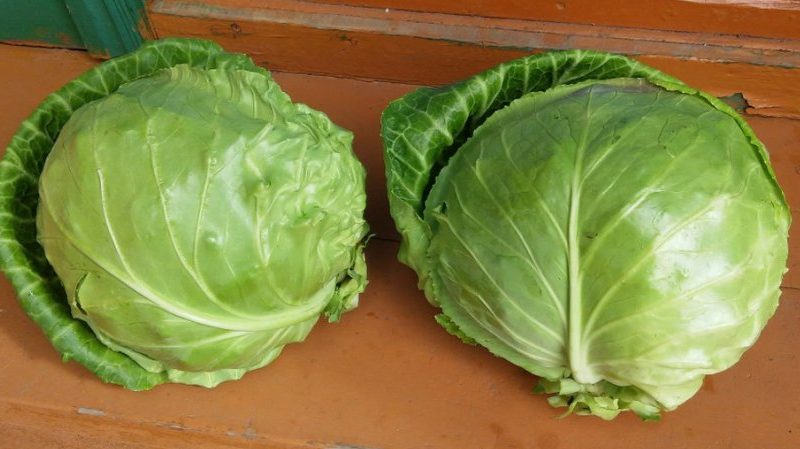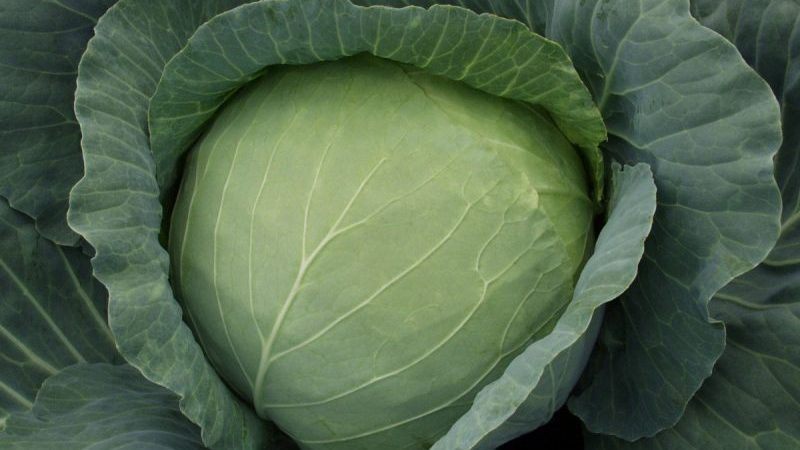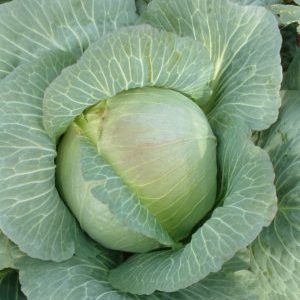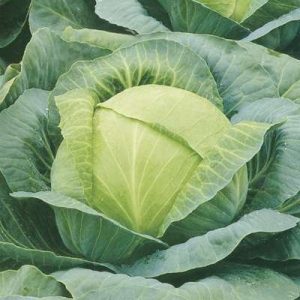Overview of the Kharkov winter cabbage variety: reviews, characteristics and cultivation features
Kharkiv winter - popular among vegetable growers grade late-ripening white cabbage, which has many positive characteristics. To get the best result, spending a minimum of effort and time, you should familiarize yourself in advance with the rules for planting a vegetable and the requirements for caring for it.
The content of the article
What is this grade
Kharkiv winter - white cabbage, bred by Ukrainian breeders of the Research Institute of Vegetable and Melon Growing as a result of crossing Amager 611 and Dauerweiss varieties.
The variety was approved for use in Russia (except for the Northern, East Siberian and Far Eastern regions) in 1976.

Description and characteristics
The variety is distinguished by late ripening - 150-170 days pass from mass seedlings to technical maturity of heads. Marketable yield - 11-12 kg / sq. m.
The Kharkiv winter one without any problems tolerates an increase in air temperature to + 40 ° C and a decrease to -3 ° C, so it is not afraid of the first autumn and return spring frosts. Easily tolerates cabbage and lack of moisture - drought does not negatively affect yield, taste and marketability.
Consumer qualities
The variety is characterized by round or slightly flattened, dense, medium-sized heads of cabbage, the diameter of which is 30-40 cm, and the weight varies from 2.7 to 4.7 kg.
Covering leaves are white-green in color with a bluish tinge, smooth or slightly wrinkled, covered with a waxy coating. They fit snugly against the head of cabbage and protect the forks from heat or frost. In section, the heads of cabbage are mostly white, but in the center it turns into cream, and the parts adjacent to the covering leaves may be greenish. The stump reaches a length of 15-20 cm, while it is rather thin. There are no rigid veins and leaf bases inside the heads.

The variety has a sweet taste, high sugar content, juiciness and pronounced cabbage leaf aroma. Kharkov winter contains a lot of vitamin C, fiber and trace elements, including potassium, sulfur and zinc. The variety practically does not produce waste - approximately 93% of the vegetable is consumed.
Cabbage of this variety is consumed fresh, fermented, used for preparing salads and hot dishes, stewed and included in pie fillings, and canning, pickle and pickle.
Advantages and disadvantages of the variety
Pros of the variety:
- amicable ripening of the crop;
- drought, pest and disease resistance;
- no tendency to cracking;
- long-term storage, good keeping quality and transportability;
- universal application;
- high productivity.
There are no significant drawbacks in the Kharkov winter one. Minor disadvantages include the likelihood of heads falling due to a long stump - they may have to be propped up and hilled.
Growing features
Kharkov winter grows well in loose, light and fertile soil with good moisture and air permeability and neutral (pH 6.5-7) or weak (pH 7-7.5) acidity. The best option is sandstones and loams.
This is a light-loving plant, therefore, a place for planting is chosen on the southern side of the site.
Reference. Cabbage can be planted in the same place after four years. The best predecessors are onions, potatoes, cucumbers and legumes.
Landing
This variety of cabbage can be grown in seedling and seedling methods.In the first case, sowing seeds in open ground is carried out in late April - early May, in the second - about 1.5 months before the plants are transplanted into the ground. In regions with a temperate climate, this time falls on the beginning of April.
Substrate for growing seedlings can be bought at a garden store or prepared by yourself by mixing equal parts of peat, river sand and sod land and adding 2 tbsp of the resulting mixture to 10 liters. l. wood ash and 1 tbsp. l. dolomite flour and superphosphate.
7-10 days before sowing the seeds, the soil mixture is frozen, calcined in the oven or spilled with a solution of potassium permanganate for disinfection.
In order to avoid the development of diseases, seeds in advance for 30-40 minutes. soaked in a solution of manganese or fungicides. To improve germination, the planting material is immersed in hot (+ 50 ° C) water, then laid out on fabrics and put away in a cool place at + 5 ° C for 12 hours.
The substrate is poured into the prepared containers and the seeds are scattered over its surface, deepening by about 0.5 cm. The containers are covered with polyethylene to create a greenhouse effect and removed to a warm (+ 22 ... + 25 ° C) place. After emergence, the film is removed.
Water the seedlings with warm, settled water with the addition of potassium permanganate as the top layer of the soil dries out, feed it twice with a solution of cow manure, provide it with daylight hours, lasting at least 12 hours and dive when 2-3 leaves appear on the seedlings.
Important! Watering the seedlings is stopped 7 days before transplanting into the ground.
Transplanting seedlings:
- Prepare the land on the site - dig it up, add for each square. m. a bucket of humus, 2-3 buckets of sand, 1-1.5 kg of chalk or dolomite flour and mineral fertilizers.
- Prepare the beds at a distance of 60-70 cm from each other.
- Make planting holes in them 5-10 cm deep.
- Place plants in them so that the distance between them is 35-40 cm.
The timing of transplanting seedlings depends on the date of sowing the seeds, on average it is the middle or end of May.
Care
During the first week after transplanting, the seedlings are watered daily, then 1-2 times a week, pouring 15-20 liters of water under each plant.
Top dressing is applied four times per season:
- 2 weeks after planting the seedlings - a solution of cow manure;
- after another 14 days - also a manure solution;
- after 6 weeks - phosphorus fertilizers (nitrophoska);
- on the 9th week after planting the seedlings - a solution of nitrophoska or cow dung.
To improve moisture and air permeability, the soil is regularly loosened to a depth of 5-7 cm and weeded, removing weeds.
Hilling is carried out as necessary. Most often, the procedure is carried out 10 and 40 days after planting.
Protection against diseases and pests
The variety is resistant to most diseases typical of cabbage, including mucous bacteriosis, fusarium wilting, rot and necrosis, and thanks to the waxy bloom that covers the leaves of the cabbage, the crop does not infect garden fleas and aphids.
For the prevention of diseases and attacks of pests, plants are treated with fungicidal (Fitoverm, Inta-Vir, Decis) and insecticidal (Gerold, Aliot, Mukhoed) preparations.
If cabbage is planted in sour and heavy soil, keela can hit it. To avoid this, choose the right site and prepare the soil.
Among pests, slugs are the most dangerous. To combat them, a mixture of 2 liters of wood ash is scattered over the beds, 2 tbsp. l. table salt, 2 tbsp. l. ground black pepper and 2 tbsp. l. mustard powder.
Harvesting and storage
The crop is harvested 150-170 days after germination on a clear and dry day. In a temperate climate, this is mid-September or the second half of October. It is advisable to be in time before frost, since, despite the frost resistance of the variety, prolonged exposure to low temperatures leads to decay of the heads of cabbage during storage.
Reference. You can take your time with the harvest - the heads of this variety do not crack, even if they are in the beds for a long time.
The collected heads of cabbage are carefully examined and sorted, removing cabbage waste and setting aside small non-standard specimens for early consumption. After that, the crop is laid out under a canopy and left to dry for about 5 hours. Leaving the cabbage in the sun will cause it to wilt.
Store harvest in a dark, cool (0 ... + 2 ° C) place with good ventilation and air humidity 85-95% for six months. To increase the shelf life, the heads of cabbage are pulled out from the beds, and not cut, and then hung by the stump down by the head.
Farmers reviews
Experienced vegetable growers speak positively about Kharkov winter cabbage.
Galina, Tula region: “For the first time I bought seedlings of the Kharkov winter about 6 years ago and since then I have grown only this variety. I do not have the best conditions in the garden - there is a lot of shade, and the soil is not ideal, nevertheless, the yield is always at its best: there is enough cabbage for a large family for the whole winter. I store the harvest in the basement, the cabbage does not deteriorate until the early varieties begin to ripen. "
Inna, Bryansk: “We have been growing this variety for a long time, for more than 10 years. Once the seller in the store advised her husband the seeds of the Kharkov winter, they are still grateful to her for this. The yield is consistently high, the heads of cabbage are large, tasty, stored perfectly, and I can’t call the care too laborious. ”
Anton, Moscow region: “The variety is excellent, but in the first year I almost ruined the planting, because I watered them too often and abundantly. As a result, the roots almost began to rot. Thanks to the neighbors, who then taught me how to save the harvest - just stop watering. I don’t make such mistakes anymore and every year I collect a rich harvest of delicious and beautiful cabbage, which, moreover, is perfectly stored ”.
Conclusion
Kharkovskaya Zimnaya is a variety of Ukrainian selection, which has a number of advantages, while having practically no drawbacks. Among the main advantages of cabbage are universal use, excellent keeping quality and consistently high yield with simple care, which consists only in timely fulfillment of basic agrotechnical requirements.